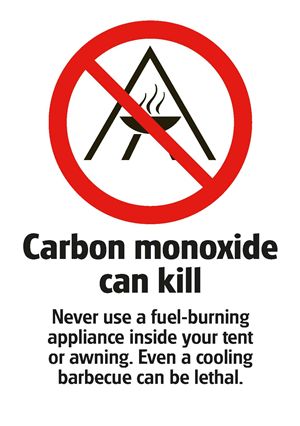Over the last few months the Club has changed its position on the use of carbon monoxide (CO) alarms in tents. If you’ve followed our deliberations you may remember we were concerned the current European standard (EN 50291) didn’t seem to cover the conditions found inside a tent.
My colleague Ian Hewlett and I met with Leigh Greenham from CoGDEM last year.
CoGDEM is the organisation for members of the gas detection industry. It obviously has an interest in selling CO detection systems, but its members are also doing significant research into the efficacy of sensors and alarms, sadly often prompted by loss of life. Leigh was able to share with us some ‘company confidential’ CO alarm testing data that’s not generally available.

In cases like these I tend to use my Jonathan Jones test, named after a
friend who’s a professional sceptic. I simply ask myself “Would Jonathan consider this sufficient proof in this case?”
In truth, the answer is probably “No”. We haven’t seen data to show that a CO alarm that’s been stored in freezing, damp conditions for a couple of winters will definitely work properly in a tent after a fortnight’s holiday with continuous rain. But I’m now happier that the sensors have been tested in damp conditions and seen little degradation. The reality is that such poor conditions would probably trigger a fault signal because the electrical circuit failed before the sensor stopped working.
As a result, we’ve changed our recommendations about using a CO alarm in a tent.
The best advice – of course – remains to avoid any chance of getting CO poisoning in the first place, by making sure there’s no source of the gas inside your tent. In particular – never take a charcoal barbecue inside, unless it’s completely cold.
If you would like the extra reassurance of a carbon monoxide alarm – perhaps in case there’s a source of CO outside that might blow in – look for one that meets the EN50291-2 standard. This has undergone extra vibration testing (over and above the -1 standard, designed for domestic CO alarms) so it’s likely to withstand journeys to and from a campsite.
It’s also worth choosing an alarm with a sealed-in Li-ion battery rather than AA or AAA batteries. The Li-ion ones should keep working at a lower temperature so you’re less likely to get a low-battery warning if it gets cold at night.
Also, keep your CO alarm in a warm, dry place. This probably means removing it from your camping kit over the winter and keeping it at home, not storing it in a freezing garage. And finally – always test the alarm when you start using it again.
In any case – we hope
the message about the dangers of CO poisoning is getting out on the campsite so we won’t need to be posting about it again during the 2014 camping season!